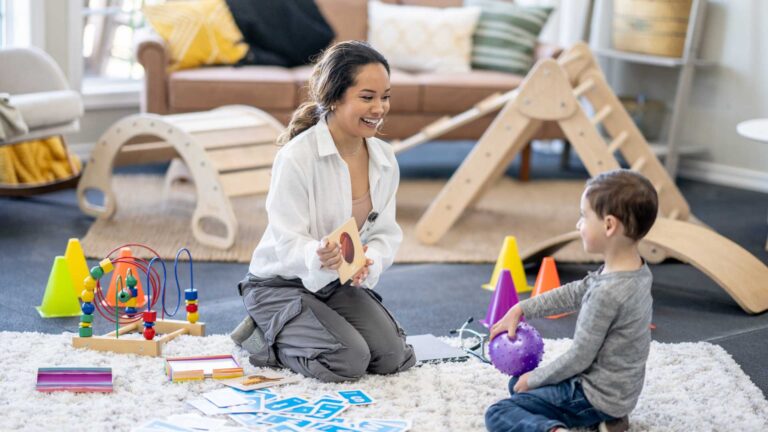How do visual supports help autism?
For individuals living with autism, engaging in communication and social interactions can often be more challenging than for those who are neurotypical. This difficulty can impede their comprehension of verbal communication and their expression of their needs. Here is where visual supports for autism come into play. These supports can range from pictures and objects to written words and photographs. They serve as invaluable tools in aiding the communication processes of those with Autism Spectrum Disorder (ASD).
Many parents and caregivers may have heard of visual supports and wondered, “How do visual supports help autism?” The answer lies in the way these supports offer an alternative means of communication for children with autism, helping them to understand their environment better.
At ABA Centers of Florida, we offer ABA therapies to help children diagnosed with ASD, some of whom face severe communication challenges. We have observed firsthand how visual aids can contribute significantly to the lives of children with autism by providing many benefits, which we will discuss in this blog. Parents, teachers, caregivers, and professional care providers can implement these visual supports for autism at home, in schools, or in any setting where the child requires support. By incorporating the use of visual supports and autism therapies, we can enhance communication and understanding, ultimately improving the quality of life and independence for those living with ASD.
Visual Supports for Autism: A Crucial Aid for Comprehension
Visual supports for autism are pivotal in providing a tangible means of interpreting the environment and enhancing the interaction of neurodiverse individuals with others. These visual aids may encompass photographs, drawings, objects, written words, checklists, and reminders.
Each child with autism has unique needs, and caregivers must choose the type of aid and its application according to the individual requirements. For instance, visual schedules can be particularly beneficial for neurodiverse children. They offer a clear understanding of the day’s activities, reduce feelings of uncertainty that could escalate anxiety, and aid in communicating their needs or desires. Moreover, Applied Behavior Analysis (ABA) experts often employ visual tools to teach new skills and behaviors.
The relationship between visual supports and autism is intertwined, with the former playing an indispensable role in enabling children to comprehend and engage with their surroundings and the people in their lives. The effective utilization of visual supports can empower children with ASD to achieve a greater level of independence, leading to a more fulfilling life.
Seven Benefits of Visual Supports for Autism
- Enhanced Communication: Visual supports for autism are tools or strategies that render information more concrete, thus facilitating understanding and fostering effective communication between parents, caregivers, teachers, family members, and generally anyone interacting with a neurodiverse individual.
- Facilitated Expression: Visual aids can bridge the gap between the abstract realm of thoughts and emotions and the tangible world of words and actions for children with autism.
- Improved Social Skills: Visual supports provide children with a means to interact with peers, family members, educators, and caregivers without feeling overwhelmed or anxious.
- Increased Independence: Visual supports and autism management often go hand in hand. These aids can serve as an effective tool for teaching essential skills like brushing teeth, ordering food, or getting dressed. These skills foster independence for individuals with autism and lighten the load on caregivers.
- Reduced Anxiety: Difficulties in communication and expression can heighten feelings of frustration in people with autism. Tools that facilitate such interactions can help alleviate stress. Additionally, using visual aids to prepare for changes in events or to establish routines often results in less worry for those with autism.
- Learning Concepts: Parents and caregivers can employ graphic cards to teach their children various concepts, from colors, places, and people to different actions.
- Customizable Aids: Each child with autism has unique needs, and fortunately, there is a vast array of visual supports available. From schedules and calendars to choice boards and people locators, you can explore these and more at the Center for Autism and Related Disabilities at the University of Florida.
Leveraging Visual Supports for Autism at Home
Life is filled with various changes – starting school, navigating puberty, transitioning into adulthood, and adapting to the year’s changing seasons. Each shift changes routine for kids in the spectrum, such as returning to school or vacationing. Visual supports for autism are invaluable tools that help children prepare for any disruption in their daily schedule.
Preparation is paramount in managing autism. Parents and caregivers can assist children in coping with imminent changes by establishing expectations ahead of time. For instance, an illustrated schedule can enable a parent or an ABA therapist to elucidate the day’s sequence of events at school for a child with autism. This approach can significantly alleviate anxiety and decrease the incidence of meltdowns.
Parents and caregivers can also design visual supports for specific experiences. Suppose your child has a dental appointment. Addressing this event beforehand can aid them in comprehending what to expect. By reviewing the sequence of a dental visit – complete with images of waiting rooms, dentists, dental equipment, and dental offices – you can help ease their apprehension. Including a fun activity after the stressful event, visible on their schedule, can provide additional encouragement.
Incorporating visual tools at home can further facilitate teaching new concepts and skills. Flashcards featuring colors, objects, people, places, and words offer an ideal method for your child with autism to learn to identify these elements.
Resources and Services for Visual Supports for Autism
Families can find cost-effective materials and services to develop visual support for their children with ASD. One viable option is to contact local autism organizations or therapy centers that offer resources through their programs or partnerships. Autism Speaks, Autism Parenting Magazine and the University of New Mexico are among the organizations providing guidelines for crafting visual supports for children with autism.
Furthermore, many states provide financial assistance programs for autism therapies and associated services, including visual aids. ABA Centers of Florida is a therapy center specializing in Applied Behavior Analysis (ABA), which incorporates visual supports and offers in-home services in various locations, including Doral, Miramar, Port St. Lucie, Tampa, Orlando, Boca Raton, Melbourne, Davenport, Kissimmee, and Bradenton. When contacting ABA Centers of Florida, the staff will contact your insurance company to ascertain if your plan covers autism therapies. If your insurance does not cover autism therapies, they will find a way to offer discounts or scholarships to families requiring financial aid for autism-related services.
More Information About ABA Centers of Florida
Visual supports and ABA therapy are instrumental approaches to empower the development of children with autism. These strategies foster understanding, communication, independence, and learning for children on the spectrum. ABA therapists, such as Registered Behavior Technicians (RBTs) and Boards Certified Behavior Analysts (BCBAs), can tailor both visual aids and ABA sessions to meet each child’s needs, offering benefits across a wide range of situations.
At ABA Centers of Florida, we integrate visual supports into our ABA therapies, assisting children in excelling in areas that require enhancement. This approach has proven effective in helping children acquire new skills, improve their communication abilities, better understand their environment, and lead a more fulfilling life. In numerous instances, visual supports have granted children with autism a voice they might not otherwise possess.
For further information about ABA therapy and visual supports for autism, please call us at (772) 773-1975 or provide your contact information on our website. Let’s work together to enhance the quality of life for neurodiverse families!








